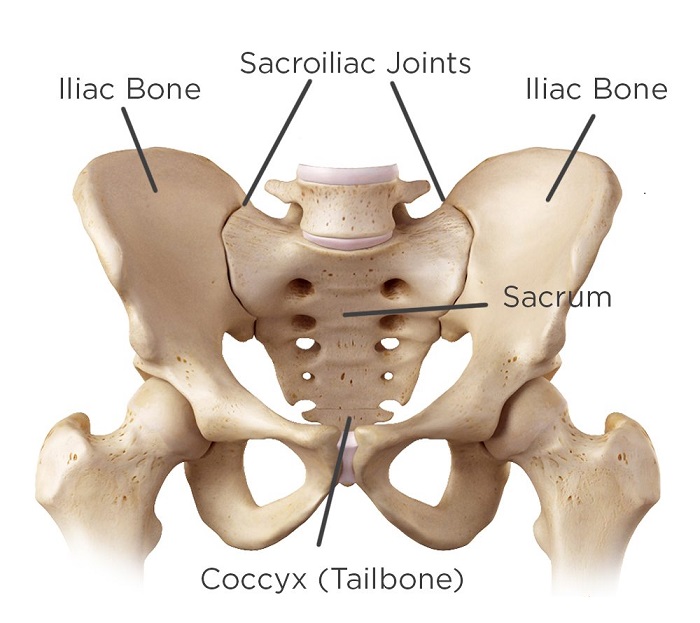Sacroiliac Joint Dysfunction

What is Sacroiliac Joint Dysfunction?
The sacroiliac (SI) joint lies next to the sacrum (tailbone) and the iliac portion of the pelvic bone. The top portion of each ilium can be felt through the lower abdominal wall just below and lateral to the umbilicus. The pelvic bone connects to the hip joint so that the upper portion of the leg bone (femur) can attach to the pelvis.
The joint is small and strong, has strong ligaments attached, does not move independently, transmits the forces of the upper body to the hips and legs, and acts as a shock absorber. Disorders of the SI joint can cause low back pain. Inflammatory conditions such as sacroiliitis may be the result of arthritic conditions, SI joint dysfunction, degeneration of the SI joint, or misalignment of the joint.
The joint is small and strong, has strong ligaments attached, does not move independently, transmits the forces of the upper body to the hips and legs, and acts as a shock absorber. Disorders of the SI joint can cause low back pain. Inflammatory conditions such as sacroiliitis may be the result of arthritic conditions, SI joint dysfunction, degeneration of the SI joint, or misalignment of the joint.
Patient Education Video
What are the Symptoms of Sacroiliac Joint Dysfunction?
Pain in the thigh or buttock that may radiate down the back of the leg like sciatica is one possible symptom. Most commonly just on one side, SI joint dysfunction is more common in young and middle-aged women. The pain is a result of excessive, too little or abnormal movement of the joint. Pain may be worse with sitting or worse when rolling over in bed. Stiffness of the hips and lower back after waking is common.

What Causes Sacroiliac Joint Dysfunction?
The source or cause of SI joint pain can be due to too much movement called hypermobility that leads to instability. Pregnancy hormones and the pressure of the growing baby may cause this hypermobility. This may explain why it is more common in young women. In other cases, not moving enough or hypomobility can lead to fixation. Both cause pain and stiffness. With fixation, the pain is often in the buttocks, usually one-sided. It can radiate to the knees or ankles. Fractures to the pelvis may result in fixation symptoms.
How to diagnose Sacroiliac Joint Dysfunction?
The diagnosis can be difficult because the causes of back pain can be multi-factorial. Back strain from lifting, facet syndrome, disc herniation, inflamed spinal cord roots, and sciatica can be confused with SI joint dysfunction. A careful history with probing questions, along with a physical exam, eliminating other causes of back pain, and nerve block injections can be helpful to make the diagnosis. Many times the diagnosis is missed. If injecting lidocaine (numbing medication) into the joint under real-time CT imaging guidance relieves the pain, the diagnosis can be firmly established.
An associated condition is known as muscular problem known as piriformis syndrome. The piriformis is in the buttock and stabilizes the SI joint. It sits close to the sciatic nerve and when irritated can mimic the symptoms of sciatica and SI joint dysfunction.
An associated condition is known as muscular problem known as piriformis syndrome. The piriformis is in the buttock and stabilizes the SI joint. It sits close to the sciatic nerve and when irritated can mimic the symptoms of sciatica and SI joint dysfunction.
How is Sacroiliac Joint Dysfunction Treated?
1. Ice, Heat, and Rest
Ice packs help with acute pain and should be applied to the area of inflammation for 15-20 minutes at a time. Ice packs can be continued intermittently for two weeks to allow inflammation to subside. At that point, heat can help soothe the area. But, in general, heat can increase inflammation in the acute phases.
2. Medications
NSAIDs reduce pain and swelling, Acetominophen is useful for pain and does not have the GI upset that NSAIDs have.
3. Chiropractic Manipulations
It can be effective when the SI joint is fixated or "stuck." It may be irritating if the SI joint is hypermobile. Specific manoeuvres are side-posture manipulation, drop technique, blocking techniques, and instrument guided methods.
4. Supports or Braces
If the SI joint is loose, a brace or belt can be wrapped around the waist to stabilize the area.
5. Physical Therapy and Exercise
Physical therapy, low impact aerobics, water exercises may be helpful to strengthen the muscles in cases of hypermobility and increase the range of motion in cases of fixation.
6. Sacroiliac Joint Injections
Injecting lidocaine and steroids into the joint are also therapeutic besides being diagnostic. Due to the relief of pain, the patient with SI joint dysfunction can start physical therapy and require fewer pain medications. Radiofrequency ablation may help relieve chronic pain, and fixation surgery is reserved for severe joint instability.
7. Stem Cell Regeneration
Stem cell regeneration is an experimental and non-invasive treatment for a damaged and painful Sacroiliac joint. For many years patients have achieved promising results from targeted stem cell treatments of the hip and knee joints, and in the SI joint this is also possible. During the treatment, stem cells are carefully injected either paraspinally or into the SI joint and surrounding ligaments. Usually CT imaging guidance will be used by an orthopaedic specialist. The cells respond to inflammatory signals from the inflamed joint and start working to repair and regenerate the joint. This can be assisted with shockwave therapy and other supportive therapies.
8. Sacroiliac Joint Fusion Surgery
Due to advancements in technology and technique, an SI fusion can be a minimally invasive procedure involving one or two small incisions right above the buttock(s) below the waistline, on either side of the spine. Instead of a lateral approach, this posterior approach minimizes injury to surrounding tissue, such as muscle. A synthetic bone matrix is introduced to help strengthen the fusion, along with threaded screws to fixate the bone during this time. Our team includes highly experienced surgeons in this technique, and you can find further information on SIJ Fusion Surgery here.Surgery & Treatment for Sacroiliac Joint Dysfunction
At Spine Connection we have regenerative and surgical treatments for all spine conditions. As every case is unique we encourage you to receive and compare opinions from our Neurosurgeon and Orthopedic Spine Specialists. We are here to help.
Begin My Assessment
Ask Our Doctors
Join Our Youtube Channel
Watch videos showcasing the latest technologies and surgery techniques, and keep up to date with patient stories from around the globe.








